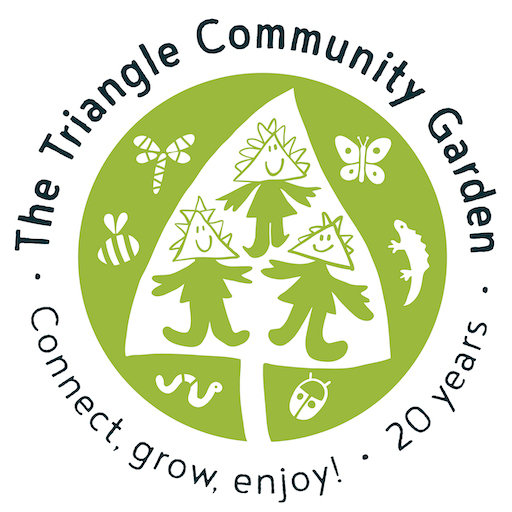The Triangle Community Garden was started in 2000 by a small group of Hitchin residents, keen to provide an open space that could be used creatively by the community. Once the site was found, and permission granted by North Herts District Council, open design workshops were held to decide what people wanted out of the Garden and what form the layout should take. Common themes emerged such as gardening organically, encouraging wildlife and the idea of the garden as somewhere peaceful, attractive and restorative.
The first five years of the garden’s development saw the creation of many of the features originally planned including the pond, raised vegetable beds, the willow maze, and the central meeting space. Some of the features you can see at the Garden today have evolved through discussions at our public progress meetings, like the sensory garden, the orchard and the spiral earth mound. The gradual development of the Garden has been accompanied by a proliferation of wildlife, including frogs, newts, lizards, bees and butterflies.
Once the Garden was substantially laid out, we started to plan ways of extending its benefits more widely within the community, particularly towards disadvantaged groups. Inspired by community gardens such as Earthworks St Albans and the horticulture therapy charity Thrive, we started a pilot project providing gardening sessions for people with learning disabilities, Started in 2005, this was run by volunteers and aided by community care workers from local day centres.
Why is it called the Triangle Garden?
The garden is roughly triangular in shape, bounded by the River Hiz, the railway line and the edge of the Rec, but the name came from the Triangle Festival first held in Summer 1981in Ransom’s Rec as a street festival for the community living in the area between Walsworth Road, Nightingale Road and Verulam Road (and associated streets between Nightingale Road and the river).
‘There was a strong feeling that there was a unique and vibrant community and culture in our corner of Hitchin and we wanted to celebrate this and share it’ says Pete Myatt in the Hitchin Historical Society book Two Minutes to the Station (ISBN: 978-0-9552411-5-4). ‘The area had developed a strong community spirit and united with some success in opposition to the Council’s plans to demolish large swathes of it in the early 70s; it was at this time that it became known as the Triangle and there was a strong sense of defiance – despite being told that our houses were “not fit for pigs to live in” we were still here and proud of it!’
The Triangle area was first built on in Victorian times when the railway came to Hitchin (the first steam train arrived in 1850), and was threatened with demolition and redevelopment (including the loss of Ransom’s Rec to housing) in the 1970s. Fortunately pressure from local residents and conservation groups stopped the redevelopment proposals, and the Triangle name lives on in the community garden, reminding us of how precious and precarious our local communities and greenspaces are, and how valuable they are both to people and nature.
In 2008 we set up the current Growing Ability social therapeutic horticulture project, run by trained horticulture therapists, and providing a structured programme based around the support needs, abilities and personal development aims of each individual. Its healthy living sister-project Growing Health followed in 2013. In 2021 we amalgamated the two projects, incorporating many of the activities from Growing Health such as food prep, cooking and regular exercise, into our Growing Ability sessions, using our new outdoor kitchen. By that time all our sessions were based outdoors under our allotment shelter, and nature-based arts and crafts had become a much enjoyed part of our programme.
In 2009 we discovered permaculture and hosted our first ‘Introduction to Permaculture’ course followed by a full Permaculture Design Course, run by Hannah Thorogood of Designed Visions. This introduced us to the three key ethics of permaculture: earth care, people care and fair shares, which we realised represented the essence of our work. The Garden became an accredited LAND project, one of a network of permaculture demonstration projects across the country. At round about this time we also achieved Registered Charity status.
In 2010 we were able to start using the newly-refurbished Pavilion as a base for our projects and workshops and in 2013 we began creating our Food Forest along the banks of the River Hiz. Today we mainly run our activities outdoors, using the Pavilion as an office during the week and hiring it out for workshops and meetings on evenings and weekends.
In 2021 we set up our New Shoots wellbeing project as a response to the mental health challenges exacerbated by the pandemic, and in 2022 we launched our monthly Family Forest School and Triangle Tribe provision in collaboration with Culturewood CiC, as another way of using the Triangle Garden to increase community cohesion and resilience, and to connect people with the natural world.
